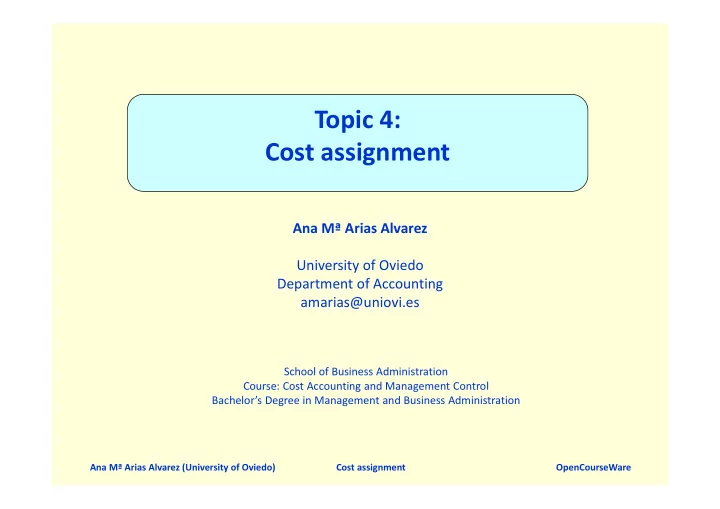

Topic 4: Cost assignment Ana Mª Arias Alvarez University of Oviedo Department of Accounting amarias@uniovi.es School of Business Administration Course: Cost Accounting and Management Control Bachelor’s Degree in Management and Business Administration Ana Mª Arias Alvarez (University of Oviedo) Cost assignment OpenCourseWare
4.1. Introduction. 4.2. The allocation process of overheads. 2/12 Ana Mª Arias Alvarez (University of Oviedo) Cost assignment OpenCourseWare
4.1: INTRODUCTION. Indirect costs (overheads) cannot be identified specifically and exclusively with a given cost object. They comprise a sizeable percentage of the costs assigned to products. 3/12 Ana Mª Arias Alvarez (University of Oviedo) Cost assignment OpenCourseWare
DIRECT COSTS Cost tracing Second ‐ stage PRODUCTS allocations PRODUCTION COST CENTRES INDIRECT COSTS Reallocation SERVICE COST CENTRES 4/12 Ana Mª Arias Alvarez (University of Oviedo) Cost assignment OpenCourseWare
THE TWO ‐ STAGE ALLOCATION PROCESS: 1. Indirect costs (or overheads) are allocated to cost centres (or cost pools). 2. Costs accumulated in cost centres are allocated to products using selected allocation bases. COST CENTRE OR COST POOL : location to which overheads are initially assigned. HOW TO CHOOSE WHICH COST CENTRES (OR COST POOLS) TO ALLOCATE COSTS TO: •A cost centre / pool should be homogeneous: all the activities whose costs are included in the pool should have the same or similar cause ‐ and ‐ effect relationship with the cost ‐ allocation base. •The basis to use for allocating indirect costs must bear a relationship to the services provided by cost centres. 5/12 Ana Mª Arias Alvarez (University of Oviedo) Cost assignment OpenCourseWare
ALLOCATION BASES: • An allocation base is a measurement of a characteristic used to distribute indirect costs of a cost pool to products. • For accurate assignment of indirect costs to products, cause ‐ and ‐ effect allocation bases should be used. 6/12 Ana Mª Arias Alvarez (University of Oviedo) Cost assignment OpenCourseWare
4.2: THE ALLOCATION PROCESS OF OVERHEADS. APPLYING THE TWO ‐ STAGE ALLOCATION PROCESS REQUIRES 4 STEPS: 1. Allocating overheads to both production and service cost centres. STAGE 1 2. Reallocating the costs previously assigned to service cost centres to production cost centres. 3. Computing separate overhead rates for each production cost centre. STAGE 2 4. Assigning production cost centre overheads to products. 7/12 Ana Mª Arias Alvarez (University of Oviedo) Cost assignment OpenCourseWare
STEP 1: ALLOCATING OVERHEADS TO BOTH PRODUCTION AND SERVICE COST CENTRES. It requires the preparation of an overhead analysis sheet. There are costs which can be directly assigned to cost centres. There are other costs which cannot be traced directly to the cost centres, so they must be allocated to cost centres using appropriate first ‐ stage allocation bases. After this first step, all manufacturing overheads have been assigned to production and service cost centres. 8/12 Ana Mª Arias Alvarez (University of Oviedo) Cost assignment OpenCourseWare
STEP 2: REALLOCATING THE COSTS PREVIOUSLY ASSIGNED TO SERVICE COST CENTRES TO PRODUCTION COST CENTRES. SERVICE COST CENTRES: they exist to provide services of various kinds to other units within the organization. They do not deal directly with products, so it is not possible to allocate their costs to products. PRODUCTION COST CENTRES: they actually work on the products. After this step, all overheads have been assigned to production cost centres. The overhead allocation procedure is more complicated where service cost centres serve each other. When such interactions occur, the allocation process can become complicated, because each service department begins to accumulate costs from other service cost centres from which it receives services and these must be reallocated back to the user department. 9/12 Ana Mª Arias Alvarez (University of Oviedo) Cost assignment OpenCourseWare
STEP 3: COMPUTING SEPARATE OVERHEAD RATES FOR EACH PRODUCTION COST CENTRE. A cost driver should be chosen for each production centre. The most frequently used cost drivers are based on the amount of time products spend in each production centre. The overhead rates are calculated in this way: Cost centre overheads Cost centre direct labour hours/machine hours 10/12 Ana Mª Arias Alvarez (University of Oviedo) Cost assignment OpenCourseWare
STEP 4: ASSIGNING PRODUCTION COST CENTRE OVERHEADS TO PRODUCTS. The final step is to allocate the overheads to products through the production cost centres, using the overhead rates calculated in Step 3. 11/12 Ana Mª Arias Alvarez (University of Oviedo) Cost assignment OpenCourseWare
Task: try to solve problem 4.1. 12/12 Ana Mª Arias Alvarez (University of Oviedo) Cost assignment OpenCourseWare
Recommend
More recommend